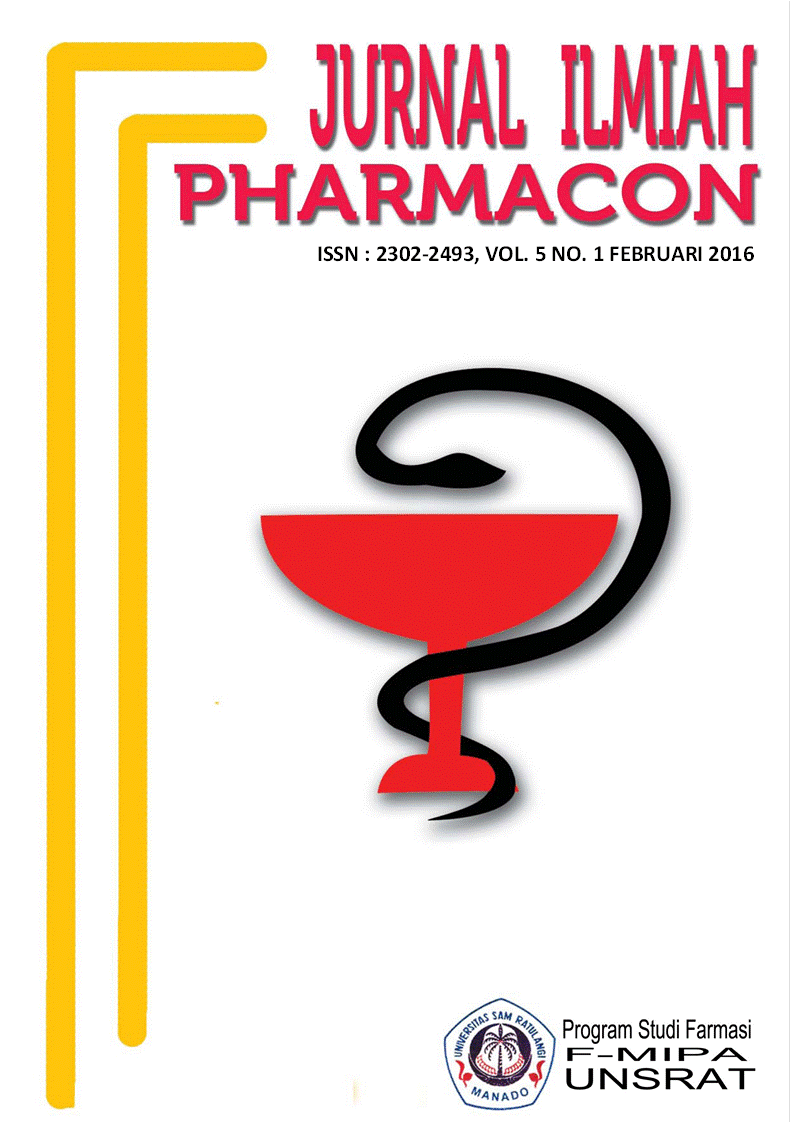PELEPASAN ION NIKEL DAN KROMIUM BRAKET ORTODONTIK STAINLESS STEEL YANG DIRENDAM DALAM OBAT KUMUR
DOI:
https://doi.org/10.35799/pha.5.2016.11233Abstract
PELEPASAN ION NIKEL DAN KROMIUM BRAKET ORTODONTIK STAINLESS STEEL YANG DIRENDAM DALAM OBAT KUMUR
Miranti Arruan Minanga1), P.S. Anindita1), Juliatri1)
1) Program Studi Pendidikan Dokter Gigi Fakultas Kedokteran UNSRAT
Â
ABSTRACT
Use of the orthodontic appliance in the mouth can be divided into two kinds of removable orthodontic appliances and fixed orthodontic appliance. Bracket is one of the basic components of fixed orthodontic appliance. Brackets are used most often made of metal or stainless steel consisting of iron, chromium, and nickel. In the process of corrosion of stainless steel bracket in the oral cavity, the release of metal ions can enter the body and cause effects like karsiogenik, allergenic, mutagenic and cytotoxic. This study aims to determine the major nickel and chromium ions are separated in the bracket soaked in mouthwash. This type of research is research laboratory eksprimental to draft a post-test only control design. The sample size determined in accordance with formula samples of numerical data. The sample used is stainless steel bracket solution that is soaked in mouthwash for 12 hours in an incubator at 37°C then be measured using a UV-Vis spectrophotometer. The results showed the average amount of nickel ion release in the control group of 1,693 ppm and the average value in the treatment group mouthwash brands A is 3,955 ppm, brands B is 3,938 ppm, brands C is 5,107 ppm. The average amount of chromium ion release in the control group of 1,000 ppm and the average value in the treatment group mouthwash brands A is 1,517 ppm, brands B is 1,193 ppm, brands C is 0,872 ppm.
.
Key words: Ion nickel and chromium, stainless steel orthodontic bracket, mouthwash
ABSTRAK
Pemakaian alat ortodontik di dalam mulut dibedakan menjadi dua macam yaitu alat ortodontik lepasan dan alat ortodontik cekat. Braket merupakan salah satu komponen dasar alat ortodontik cekat. Braket yang paling sering digunakan terbuat dari bahan logam atau stainless steel yang terdiri dari besi, kromium, dan nikel. Pada proses korosi braket stainless steel di dalam rongga mulut, terjadi pelepasan ion logam yang dapat masuk ke dalam tubuh dan menimbulkan efek seperti karsiogenik, alergenik, mutagenik dan sitotoksik. Penelitian ini bertujuan untuk mengetahui besar ion nikel dan kromium yang terlepas pada braket yang direndam dalam obat kumur. Jenis penelitian ini yaitu penelitian eksprimental laboratori dengan rancangan post-test only control design. Besar sampel ditetapkan sesuai dengan rumus sampel data numerik. Sampel yang digunakan yaitu larutan braket stainless steel yang direndam dalam obat kumur selama 12 jam dalam inkubator 37°C kemudian dilakukan pengukuran menggunakan alat spektrofotometer UV-Vis. Hasil penelitian menunjukkan jumlah rata-rata pelepasan ion nikel pada kelompok kontrol yaitu 1,693 ppm dan nilai rata-rata pada kelompok perlakuan obat kumur merk A yaitu 3,955 ppm, merk B yaitu 3,938 ppm, merk C yaitu 5,107 ppm. Jumlah rata-rata pelepasan ion kromium pada kelompok kontrol yaitu 1,000 ppm dan nilai rata-rata pada kelompok perlakuan obat kumur merk A yaitu 1,517 ppm, merk B yaitu 1,193 ppm, merk C yaitu 0,872 ppm.
Â
Kata Kunci: Ion nikel dan kromium, braket ortodontik stainless steel, obat  kumur
Â
Downloads
Published
How to Cite
Issue
Section
License
Authors who publish with this journal agree to the following terms:
- Authors retain copyright and grant the journal right of first publication with the work simultaneously licensed under a Creative Commons Attribution-NonCommercial 4.0 International License that allows others to share the work with an acknowledgement of the work's authorship and initial publication in this journal.
- Authors are permitted and encouraged to post their work online (e.g., in institutional repositories or on their website) prior to and during the submission process, as it can lead to productive exchanges, as well as earlier and greater citation of published work (See The Effect of Open Access)










